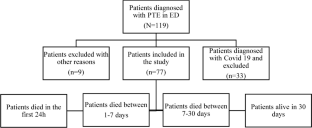SN Comprehensive Clinical Medicine Pub Date : 2024-04-13 , DOI: 10.1007/s42399-024-01671-9 Yavuz Selim Benzer , Gülşen Çığşar , Bedriye Müge Sönmez

|
Plasma lactate level of ≥ 2 mmol/L can predict pulmonary embolism (PE)-associated adverse outcomes but has led to the question of if monitoring lactate concentration can be more reliable than the adequacy of a single measurement. It could be more beneficial to use repeated assessments of lactate concentration to forecast results in this patient group. This study aims to investigate the predictive value of lactate clearance (LC) in short-term mortality in patients diagnosed with PE in the emergency department (ED). A prospective cross-sectional study was conducted in ED of a tertiary care hospital. Patients who were diagnosed with PE over age 18 were enrolled in the study. The risk factors, vital signs, and lactate levels (at arrival and the 2nd hour) at admission were recorded. The Pulmonary Embolism Severity Index (PESI) scores of the patients were calculated. The 24-h, 7-d, and 30-d survival rates of the patients were evaluated. Then, 77 patients were included in the study. PESI score, basal, and 2nd-hour lactate levels were found significant in predicting 30-day mortality (p = 0.002, 0.009, and 0.002, respectively). Receiver operating characteristic (ROC) curve analyses for PESI, basal, and 2nd-hour lactate levels showed an area under curve (AUC) of 0.703 (95% CI: 0.586–0.820), 0.688 (95% CI: 0.552–0.824), and 0.722 (95% CI: 0.586–0.857), respectively. The predictive performances of PESI, basal, and 2nd-hour lactate level were similar. LC was not significant in predicting the 30-day mortality (p = 0.290). LC was not correlated with mortality in patients with PE.
中文翻译:

乳酸清除率能否预测肺栓塞的短期死亡率?
血浆乳酸水平≥2 mmol/L可以预测肺栓塞(PE)相关的不良后果,但引发了一个问题:监测乳酸浓度是否比单次测量的充分性更可靠。使用乳酸浓度的重复评估来预测该患者组的结果可能更有益。本研究旨在探讨乳酸清除率 (LC) 对急诊科 (ED) 诊断为 PE 的患者短期死亡率的预测价值。在一家三级医院的急诊室进行了一项前瞻性横断面研究。 18 岁以上被诊断患有 PE 的患者参加了该研究。记录入院时的危险因素、生命体征和乳酸水平(到达时和第 2 小时)。计算患者的肺栓塞严重指数(PESI)评分。评估患者的24小时、7天和30天生存率。随后,77 名患者被纳入研究。 PESI 评分、基础乳酸水平和第 2 小时乳酸水平对预测 30 天死亡率具有显着意义(p 分别为 0.002、0.009 和 0.002)。 PESI、基础和第二小时乳酸水平的受试者工作特征 (ROC) 曲线分析显示曲线下面积 (AUC) 为 0.703 (95% CI: 0.586–0.820)、0.688 (95% CI: 0.552–0.824)、分别为 0.722(95% CI:0.586-0.857)。 PESI、基础乳酸水平和第 2 小时乳酸水平的预测性能相似。 LC 在预测 30 天死亡率方面并不显着 ( p = 0.290)。 LC 与 PE 患者的死亡率不相关。



























 京公网安备 11010802027423号
京公网安备 11010802027423号